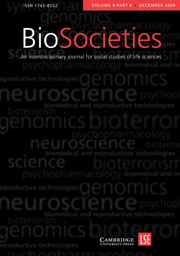Crossref Citations
This article has been cited by the following publications. This list is generated based on data provided by
Crossref.
Lazarow, Melanie
2007.
Exploring Methods in Information Literacy Research.
p.
171.
Mykhalovskiy, Eric
Armstrong, Pat
Armstrong, Hugh
Bourgeault, Ivy
Choiniere, Jackie
Lexchin, Joel
Peters, Suzanne
and
White, Jerry
2008.
Qualitative research and the politics of knowledge in an age of evidence: Developing a research-based practice of immanent critique.
Social Science & Medicine,
Vol. 67,
Issue. 1,
p.
195.
Teghtsoonian, Katherine
2009.
Depression and mental health in neoliberal times: A critical analysis of policy and discourse.
Social Science & Medicine,
Vol. 69,
Issue. 1,
p.
28.
Lézé, Samuel
2009.
Politique du freudisme : crise de la clinique et contrôle des problèmes personnels.
Journal des anthropologues,
p.
413.
Fishman, Jennifer R.
Settersten Jr, Richard A.
and
Flatt, Michael A.
2010.
In the vanguard of biomedicine? The curious and contradictory case of anti‐ageing medicine.
Sociology of Health & Illness,
Vol. 32,
Issue. 2,
p.
197.
Fishman, Jennifer R.
Settersten, Richard A.
and
Flatt, Michael A.
2010.
Technogenarians.
p.
25.
Whitley, Rob
Rousseau, Cecile
Carpenter-Song, Elizabeth
and
Kirmayer, Laurence J
2011.
Evidence-Based Medicine: Opportunities and Challenges in a Diverse Society.
The Canadian Journal of Psychiatry,
Vol. 56,
Issue. 9,
p.
514.
Kaufman, Sharon R.
Mueller, Paul S.
Ottenberg, Abigale L.
and
Koenig, Barbara A.
2011.
Ironic technology: Old age and the implantable cardioverter defibrillator in US health care.
Social Science & Medicine,
Vol. 72,
Issue. 1,
p.
6.
Kienle, Gunver Sophia
Albonico, Hans-Ulrich
Fischer, Lorenz
Frei-Erb, Martin
Hamre, Harald J.
Heusser, Peter
Matthiessen, Peter F.
Renfer, Adrian
and
Kiene, Helmut
2011.
Complementary Therapy Systems and Their Integrative Evaluation.
EXPLORE,
Vol. 7,
Issue. 3,
p.
175.
Kirmayer, Laurence J.
2012.
Cultural competence and evidence-based practice in mental health: Epistemic communities and the politics of pluralism.
Social Science & Medicine,
Vol. 75,
Issue. 2,
p.
249.
Cooper, Melinda
2012.
The Pharmacology of Distributed Experiment – User-generated Drug Innovation.
Body & Society,
Vol. 18,
Issue. 3-4,
p.
18.
Wilson‐Kovacs, Dana M.
and
Hauskeller, Christine
2012.
The clinician‐scientist: professional dynamics in clinical stem cell research.
Sociology of Health & Illness,
Vol. 34,
Issue. 4,
p.
497.
Knaapen, Loes
2013.
Being ‘evidence-based’ in the absence of evidence: The management of non-evidence in guideline development.
Social Studies of Science,
Vol. 43,
Issue. 5,
p.
681.
Kokanovic, Renata
Butler, Ella
Halilovich, Hariz
Palmer, Victoria
Griffiths, Frances
Dowrick, Christopher
and
Gunn, Jane
2013.
Maps, Models, and Narratives.
Qualitative Health Research,
Vol. 23,
Issue. 1,
p.
114.
Hinojosa, Jim
2013.
The Evidence-Based Paradox.
The American Journal of Occupational Therapy,
Vol. 67,
Issue. 2,
p.
e18.
Knaapen, Loes
2014.
Evidence‐Based Medicine or Cookbook Medicine? Addressing Concerns over the Standardization of Care.
Sociology Compass,
Vol. 8,
Issue. 6,
p.
823.
2014.
Clinical Labor.
p.
243.
2014.
Clinical Labor.
p.
195.
2014.
Clinical Labor.
p.
221.
2014.
Clinical Labor.
p.
159.

